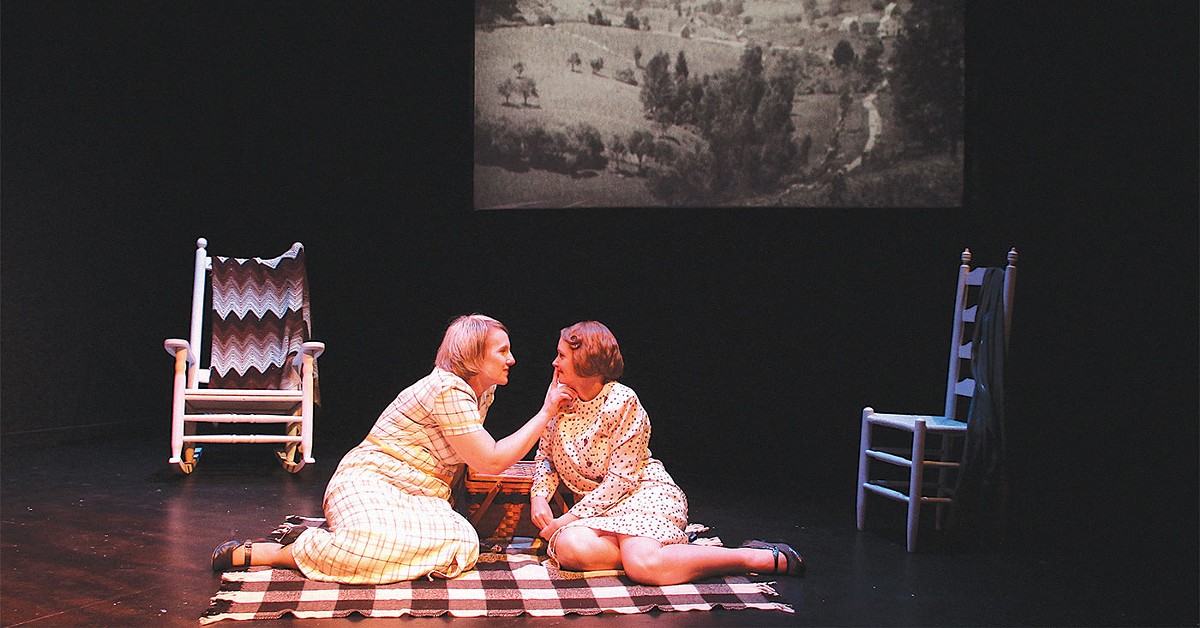More than ever, the most basic and essential functions of our humanity are transcending personal lives and finding themselves at the center of the socio-political stage. As gender and sexuality have leapt to the forefront of the greater cultural conversation in the last decade, we understand them not as succinct definitions but as spectra, on which exist any number of identifications, variables and preferences.
As this comprehension has grown, so too do we find ourselves living in a social age that encourages us to “tread lightly,” so it stands to reason that presenting these dynamics as facets of entertainment is delicate, even risky. In speaking to some of the people behind Louisville’s robust theater community, however, the curtain is pulled back to reveal a genre that allows interpretation before judgment, a notion that escapes real life all too often. The very quality that makes theater superficial is in fact the quality that often makes it more welcoming and introspective.
From across the gamut of theatrical productions in this city, ranging from traditional to unconventional, straightforward to abstract, the widely-held consensus among creative leaders is that to portray gender and sexuality sincerely, they must be evoked as part of a complete character. Just as they are pieces of a real human life but not the entire picture, they are qualities for an actor to draw on but not the whole production.
“From my own directing point of view, that’s where I start: finding the dignity and the fullness of the characters and their stories,” says Michael Drury, producing artistic director of Pandora Productions. “I feel a great deal of responsibility.” Since 2000, Drury has helmed the company, whose mission is to present theater relating specifically to the LGBTQ community.
“I think if you asked our audience, they would say the reason they love watching our shows is that no matter what the character is, who or how they identify, we’re playing those people as fully realized human beings with hearts and minds,” he continues. “With good theater, that’s what we should be watching, no matter who the character or what their sexual preference or gender.”
Actors Theatre of Louisville Artistic Director Les Waters echoes the significance of such full-bodiedness in a character, further stressing the beauty of imperfection even in the noblest of protagonists. “I think it’s important to show,” he explains, “that whatever your gender, we live in very complicated times and we’re fallible human beings. Putting goodness on stage regardless of gender isn’t particularly interesting. It somehow implies there’s no conflict and that there’s this perfect human being. I personally have yet to meet one.”
For some productions, gender or sexuality are footnotes of the character, and for others, they are a central theme. Like Pandora, local company Looking for Lilith explores the stories of a selected group, namely women. Currently celebrating their 15th anniversary, they originally showcased only original works, but in recent years, they have worked to include already-written plays that adhere to their mission of giving a platform to unheard female voices.
According to Head of Productions and Resident Director Kathi Ellis, doing so means striking the right chord between empowerment through inclusion and an accurate definition of feminism, which she stresses does not include the stereotyped intrinsic resentment of males. “Frequently, the protagonists are the female characters, but we’re always interested in telling the stories of the men who are allies, friends and activists of the issues that we’re addressing in our piece,” Ellis says. “Occasionally, that also means that the male characters are the antagonists. It’s a really interesting line to balance.”
Ellis further explains that Lilith takes inspiration from poignant perspectives in history and brings them to light either through an actual historical representation or a composite fictional character. The creation of such characters is necessary to accurately represent the variety of women’s faculties throughout history. Company founder Shannon Woolley discloses that Lilith’s manifestation and mission sprung from her own experiences as a young theater student.
“There have been women playwrights forever,” she contends, “but they haven’t been in the public eye.” Woolley contends that the American theater canon does not necessarily reflect the material available but rather the works considered viable or classical. After earning her B.F.A. from Southern Methodist University, which accepted only 15 students in the acting department annually — 10 men and five women “because they wanted as part of their program for everyone to get significant time on stage; therefore, they filled their department according to viable roles” — Woolley moved to Denver as part of a repertory company.
“We were doing a lot of work that was considered edgy,” she recalls, “and I took that at face value. But after a couple years doing that, it became really clear that the roles available to me were the prostitute or the haranguing bitch.”
Looking for Lilith’s current season opened with “Legacy of Light,” a play that juxtaposes Emilie du Chatelet, physicist, mathematician and aristocrat most often remembered in history as Voltaire’s lover, with 21st century astrophysicist Olivia. From their respective places in time and influence, both women grapple with their journeys to motherhood amid a backdrop of science and mortality. These are the roles often dismissed for women, both on stage and in much of the world.
While much of theater exposes us to a bygone time, pieces actually written many tens or hundreds of years ago present their own challenges as well as permissions, according to Amy Attaway, associate artistic director at Kentucky Shakespeare. She explains that while a piece may be historical and verbose, it is not necessarily restrictive. Those very traits, in fact, leave it more open to adaptation, and, by proxy, the audience can deduce their own meanings in the poetry perhaps more so than is possible with a 20th-century — or more recent — play.
Shakespeare, she says, is frequently prone to gender-swapped roles or all-one-gender productions with romantic relationships a constant part of the exposition. While the material presents some challenges from its distant place in history, Attaway believes an audience can take away timeless vantage points with adjustments to the tone behind the dialogue.
When she directed “The Taming of the Shrew” two years ago, Attaway was cautious to present a piece that concludes with the central character delivering a monologue about the importance of female subservience to male counterparts. “For me, the production turned into a story not about a shrewish woman being subdued but rather about two people — a man and a woman — who felt that they needed to put on masks or shows for the public,” she says. “Her disguise was the shrew and his was a brash, loud man.
Through the course of the play, they discovered that they could take off their masks with each other. The final monologue became like her inside joke performance for him.”
Throughout the month of October, Kentucky Shakespeare presented the bloodiest play from the theater titan’s career, “Titus Andronicus,” aptly from PLAY Louisville’s warehouse space in Butchertown. Attaway notes perhaps one of the most indelible elements of the piece is the tragedy’s distinct use of violence and sex, both amorous and forcible, directly for the audience to view. “Something particularly shocking about it is the rape,” she points out, “which is very blatant and plotted.” While it would be possible to view the assault at face value, it seems pertinent to take more from a 16th-century playwright’s vision of an act that has its own “culture” in present day. As the play and scene have aged together, they have somehow become intrinsically more robust and effortlessly developed deeper and richer subtext, ripe for a 21st-century reexamination.
With variant phrasing, this resident body of stage artists collectively comments on the audience’s permission to gather what they will from any given performance — the recurring privilege granted to the theater-goer that lingers on the ride home as they recollect the images and dialogue from the last two hours or so. Great theater is often described as transcendent, enveloping the audience in a story with meticulous planning and memorization. How, then, is the game changed when the element of dialogue is removed entirely?
Robert Curran, artistic and executive director of the Louisville Ballet, believes that reliance on the body alone proves a significant asset in depicting a character’s orientations, both sexual and often more importantly, emotional. “I feel that dancers have a bit of an advantage in that they have such a profound knowledge of their bodies where they can take their arms, legs, posture and head line in really any direction,” he explains. “They spend all day every day basically naked in front of a mirror looking at themselves and each other, touching each other in places that you just normally wouldn’t. There’s a physical intimacy about a group of dancers that extends far beyond the normal intimacy. Their level of comfort with their bodies and their expression of whatever they’re trying to communicate, they really do take it to an extreme.”
What might seem extreme to an audience member is an organic evolution among dancers, who seemingly exist on an elevated plane of rapport. “Once you’ve been rehearsing for an hour and a half and you’re dripping with sweat, both sliding off of one another, catching, touching and sometimes kissing, you lose your inhibitions a bit in that aspect of communication. It does extrapolate any expression, that level of intimacy that exists between human beings in a ballet company, whether it’s male-female, female-female, male-male, they’re all very much connected with each other. You can’t fake it when you’re in that kind of proximity. You can do it half-heartedly, but you definitely can’t fake it.”
Most recently, Curran choreographed “Swan Lake,” regarded by many as the ultimate ballet. Though it’s been performed many times over, with this version, Curran sought to amplify the concepts of masculine duty and feminine power. He focused intention on the contrast between the authoritative queen urging her son to choose a wife and the delicate Odette, whose stereotypical fragility wields its own power by entrancing the prince.
In the classical theater canon, one need not look hard to find stereotypes permeating any given story. What becomes evident, however, is that the literal and metaphorical stage given to such stereotypes allows the opportunity to see why or how they came to exist in the first place.
Waters highlights Actors Theatre’s October run of “Macbeth,” “which has one of the most famous roles for a woman, Lady Macbeth,” he says. “It’s one of the two major characters in the play and central to it who talks about sexuality. The play is a huge debate about male performance — what men think they are. I think in this particular instance, gender is explored in a great way by a master playwright.” His sentiments echo Attaway’s assertion that a play need not be modern to be presently relevant.
“It’s not telling you what to think, it’s just allowing the current state of the world to exist through these actors about a play that deals universally with questions of power or domination and what they mean,” furthers Actors Theatre Associate Artistic Director Meredith McDonough.
“Productions will shift according to the actors in it and what they bring to the roles,” Waters continues. “It’s our job to think of classic plays as if they’re new. Everything was a new play once, and we have to go into it and explore it according to the director’s vision. If Meredith did another production of ‘Macbeth’ next year, it would be very different. You just have to be alive to the world that you live in and be aware of repercussions.”
Like any form of entertainment, theater is subject to scrutiny depending on an audience’s expectations or impressions, hence repercussions. “I don’t think that what we do is frightening, but I’m not naïve enough to think that it’s not frightening for everyone,” Drury says of Pandora’s commitment to legitimizing the lesser-told stories. “While LGBTQ people have made a lot of progress in the last five to 10 years, there’s still a lot of fear around our community. We are who we are, and if somebody goes to our website to buy tickets and they see a picture in the banner of two men dancing, that could scare people and I’m aware of that. Aware, but disappointed.”
What better reason, though, to go to the theater? What better environment to be scared, to be enlightened, to be transported? We exist in a time when visual entertainment is accessible in our pockets. We play, pause, stop, subscribe, record, rewind, review... how often do we reflect? Many among us will sooner watch a scene of torture to be scared before we embrace depictions of our society, past and present, reflected back at us to allow extraction from the comfort zone. With regard to gender and sexuality explicitly, there hardly seems a better medium to posit their significance and subtlety as parts of a complete person and their story.






